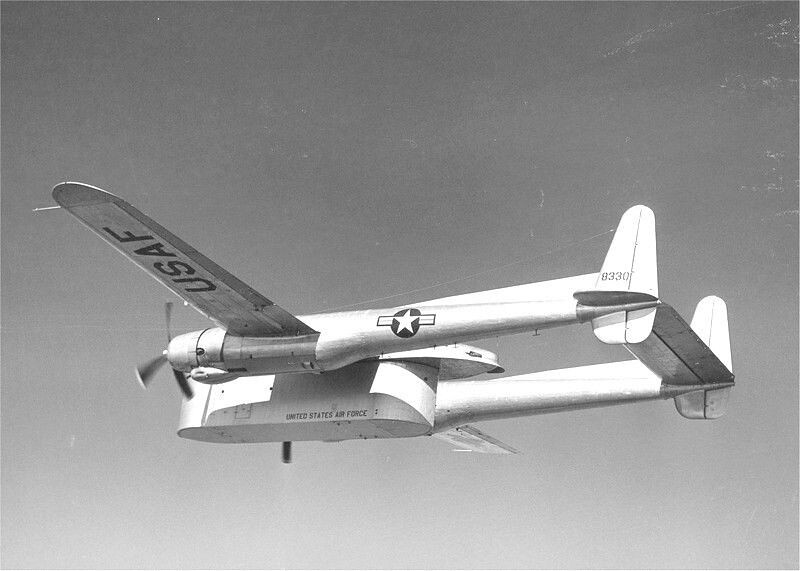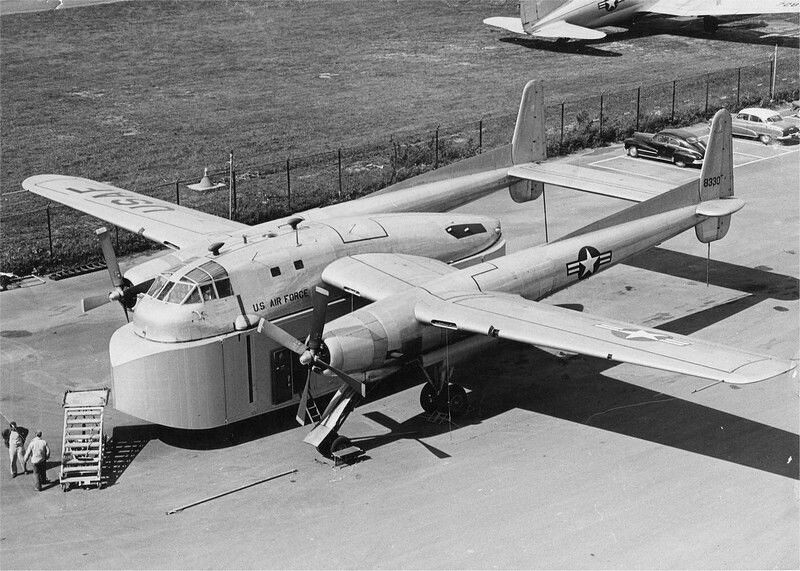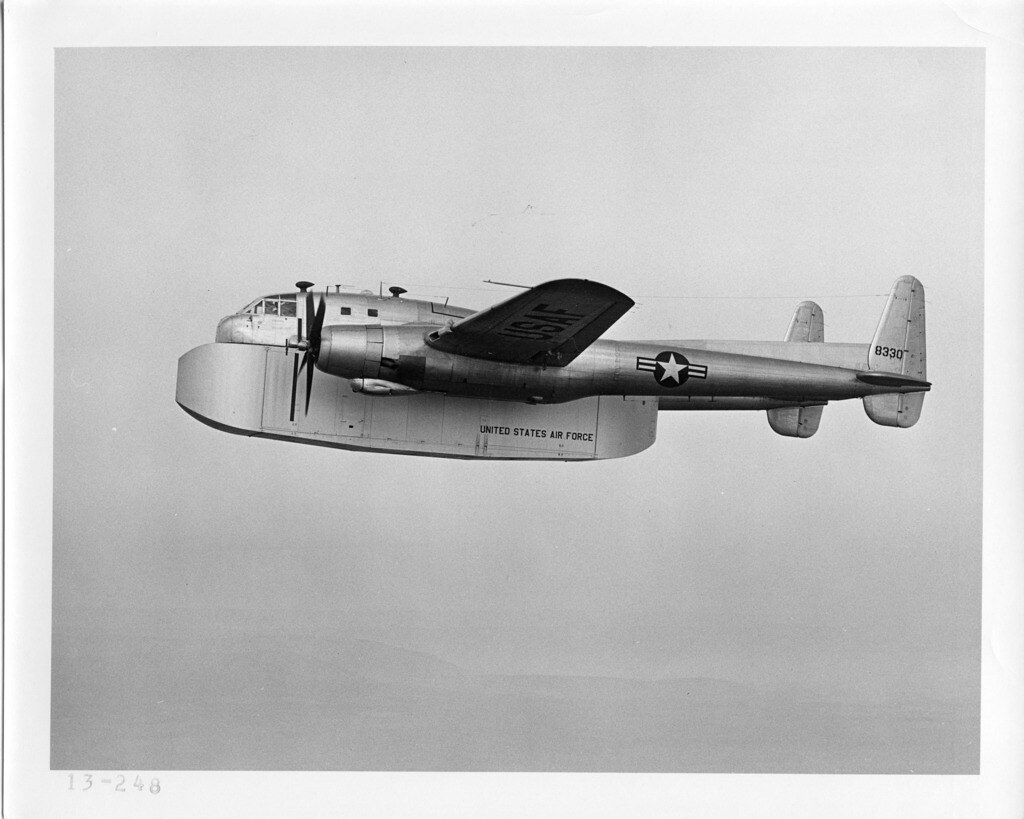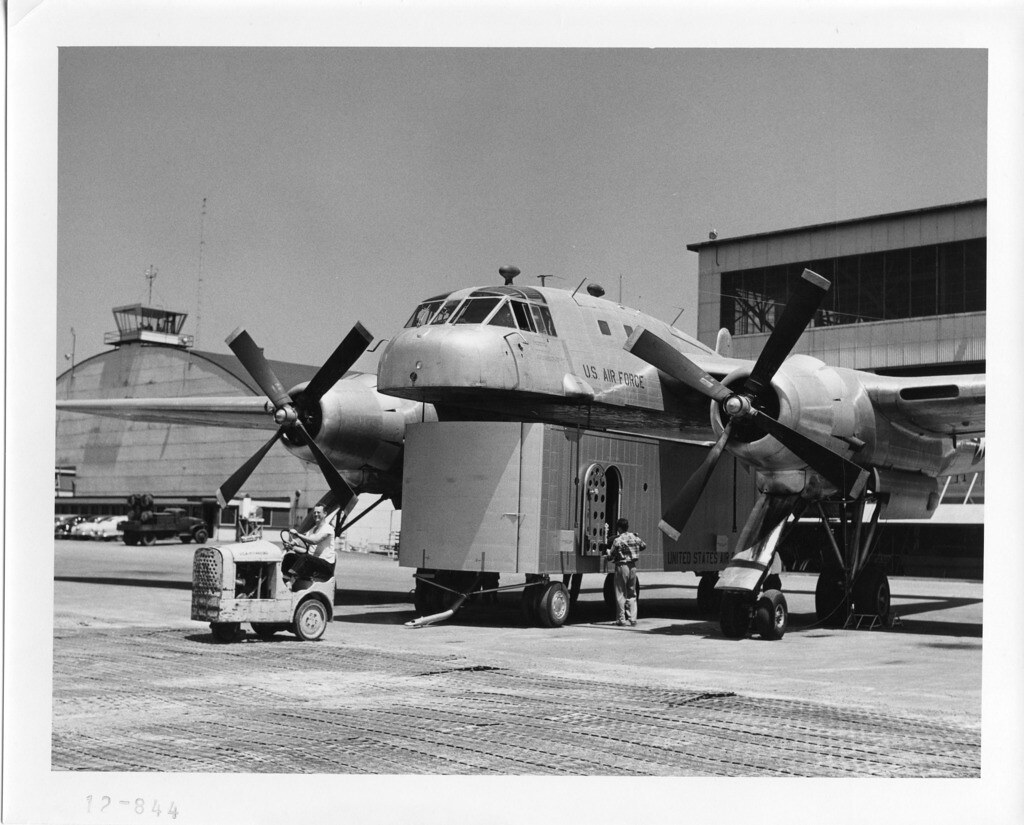Fairchild XC-120 Pack Plane Newsreels - 1950
Sun Mar 24, 2019 6:34 am
Always loved this concept.
Re: Fairchild XC-120 Pack Plane Newsreels - 1950
Sun Mar 24, 2019 11:40 am
That is just hella cool. I have an ancient Flying magazine (from my Dad's teenage years) that has it on the cover.
I believe it was built about a mile from my house. In the footage, I'm pretty sure I saw a historic hangar that was tragically and stupidly razed a couple years ago.
Seems like an excellent concept. I wonder why it didn't catch on? I loved the idea about the pods could be equipped as various sorts of shops and stations.
Nowadays of course they can unload a cargo plane much faster--just buzz the drop zone and yank the load out the back with 'chutes.
Thanks for posting this. I'd never seen it fly before, nor its other features demonstrated.
I believe it was built about a mile from my house. In the footage, I'm pretty sure I saw a historic hangar that was tragically and stupidly razed a couple years ago.
Seems like an excellent concept. I wonder why it didn't catch on? I loved the idea about the pods could be equipped as various sorts of shops and stations.
Nowadays of course they can unload a cargo plane much faster--just buzz the drop zone and yank the load out the back with 'chutes.
Thanks for posting this. I'd never seen it fly before, nor its other features demonstrated.

Re: Fairchild XC-120 Pack Plane Newsreels - 1950
Sun Mar 24, 2019 11:50 am
Snake45 wrote:Seems like an excellent concept. I wonder why it didn't catch on? I loved the idea about the pods could be equipped as various sorts of shops and stations.
It unfortunately is very impractical. It will only work if a replacement pod is already at the location the airplane is arriving at. and unlike containers used on wide body airplanes it was not usable by any other type. If a C-120 arrived at a location where another pod was not in presence then there was still a wait for the airplane to be unloaded and loaded. The logistics become impractical when you consider how many pods would have to be produced and where they were to be located for the system to work. There would have had to be a great number of (expensive) pods and the required support equipment available and in place. Some ideas like this, or the Fairey Rotodyne, look really cool. Then reality comes along and messes everything up.
Re: Fairchild XC-120 Pack Plane Newsreels - 1950
Sun Mar 24, 2019 1:06 pm
The ability to swap the cargo pod was only one option. Where the USAF saw benefit is because they could have several different pods with different configurations and that had a different use in combat - the pods weren't expected to be on both ends. The airplane was expected to drop the pod, take off without it and return to base to get another one for the next delivery. It would allow (for example) several FOBs to be quickly established because you could have a flight of planes bring in the initial setup equipment in the first round of pods, go back empty (and more maneuverable), get the next set and then pick up the first set when they returned as the FOB would then be secured and protected.
What changed was technology - large helicopters were becoming a thing (the Mojave was already in development), as were turboprops and jets weren't far behind. The USAF saw that their needs could be solved in different ways with vertical lift and faster movement instead.
What changed was technology - large helicopters were becoming a thing (the Mojave was already in development), as were turboprops and jets weren't far behind. The USAF saw that their needs could be solved in different ways with vertical lift and faster movement instead.
Re: Fairchild XC-120 Pack Plane Newsreels - 1950
Sun Mar 24, 2019 1:41 pm
CAPFlyer wrote:What changed was technology - large helicopters were becoming a thing (the Mojave was already in development), as were turboprops and jets weren't far behind. The USAF saw that their needs could be solved in different ways with vertical lift and faster movement instead.
Notably, the C-130 with some of those advancements was soon to enter the picture.
Re: Fairchild XC-120 Pack Plane Newsreels - 1950
Sun Mar 24, 2019 2:10 pm
Meanwhile, the designers at Sikorsky were taking notes... Did the Army come to the same conclusion about the Skycrane?
Re: Fairchild XC-120 Pack Plane Newsreels - 1950
Sun Mar 24, 2019 2:49 pm
Chris Brame wrote:Meanwhile, the designers at Sikorsky were taking notes... Did the Army come to the same conclusion about the Skycrane?
Seems like similar initial concepts, though the Tarhe obviously had a much more useful life without the pods.
Re: Fairchild XC-120 Pack Plane Newsreels - 1950
Sun Mar 24, 2019 2:59 pm
CAPFlyer wrote:The ability to swap the cargo pod was only one option. Where the USAF saw benefit is because they could have several different pods with different configurations and that had a different use in combat - the pods weren't expected to be on both ends. The airplane was expected to drop the pod, take off without it and return to base to get another one for the next delivery. It would allow (for example) several FOBs to be quickly established because you could have a flight of planes bring in the initial setup equipment in the first round of pods, go back empty (and more maneuverable), get the next set and then pick up the first set when they returned as the FOB would then be secured and protected.
What changed was technology - large helicopters were becoming a thing (the Mojave was already in development), as were turboprops and jets weren't far behind. The USAF saw that their needs could be solved in different ways with vertical lift and faster movement instead.
Still a very inflexible design. The perfect world of flying one way trips might seem sensible until you run out of pods. What if the mission is to fly parts/troops/supplies between Dover, Carswell, Biggs, Foster AFBs (Note most are closed now
You are right about large helicopters. Just remember they are Army, not USAF. The USAF already had airplanes that were more efficient and plenty of large lift for the time. The Army's needs are/were different and thus became mainly rotary wing.
A lot of what seemed like good ideas came and went. One of my favorites (as mentioned) was the Fairey Rotodyne. Seemed cool, but H-47s and H-53 evolved as much better machines. The V-22 finally got the role that the Rotodyne wanted. In the end the Rotodyne would have been a flying abortion.
Back to the pods: How often did the CH-54 Tarhe actually utilize them? Rarely, and when used they were very specialized (Electronics, Medical), And more importantly the H-54 could carry a good load slung under the airframe, the C-120 could not, it was just too specialized.
Tracked bogies looked cool too, but were not practical. Even with all of the projects that went nowhere there was still genius involved in the designs. You don't learn if you don't try.
Re: Fairchild XC-120 Pack Plane Newsreels - 1950
Sun Mar 24, 2019 10:06 pm
Very interesting, on the cusp of greatness. The Sikorsky CH-54 heavy lift helicopter was used for thirty years by the Army with that same pod idea.
That pod on the XC-120 looks extremely expensive to build compared to a Conex or other shipping container. I guess with the C-133, C-141 and C-5A , they figured it out.
That pod on the XC-120 looks extremely expensive to build compared to a Conex or other shipping container. I guess with the C-133, C-141 and C-5A , they figured it out.
Re: Fairchild XC-120 Pack Plane Newsreels - 1950
Mon Mar 25, 2019 9:26 am
Cliff, I think you're missing what the idea is. The "one way" trip would only be the first run. After that, you can drop a new one and pick up the previous. Again, the idea wasn't necessarily for routine flights. It was more for combat operations or operations where time was of the essence and you needed the planes to keep moving (think Berlin Airlift). Looking at it in the limited scope of peacetime operations is where the system always fails because that's not what it was intended for. I suspect in operation the pods wouldn't have been detached and the plane normally operated as a single unit as the C-119 already was. The issues of the Berlin Airlift was still fresh in everyone's mind in 1949/1950 and the primary issue they had during the operation was lack of ramp space for airplanes. The idea of being able to remove a pod for unloading off to the side while the plane took an empty pod was one way of fixing the issue. You can put 5 or 6 pods in the space of one airplane, making it possible to move more with less.
Again though, it was the coming of turboprops and turbojets that made the difference here. The C-119 could carry palletized cargo, just as the C-130 and later airplanes could, but the turboprop could carry MORE in the same package. The higher power let them put almost double the weight (45,000 lbs versus 27,500 lbs) in an airplane of nearly the same size (the C-130 is about 10 feet longer, but with a slightly shorter wing). It was that which meant such capability was less needed. Also the integration of the loading ramp meant you didn't need a specialized pod for a hospital of "base in a box". You could vehicle mount that stuff and simply roll it on and off the airplane - and that's exactly what was done.
No doubt they're Army. But that wasn't the point of my statement. The point was that the coming of the large helicopter removed the need for the USAF to fulfill certain roles in tactical army aviation doctrine. Now, the Army could use those large helicopters to sling load or (in the case of the CH-54 a decade later) container carry that initial base equipment directly to where it was needed, so the USAF didn't have that need. That's also why the USAF light tactical airlift component went away (and got "dumped" on the Army). The USAF could concentrate on the bigger equipment to move large amounts of cargo where needed by the Army while the Army moved the smaller stuff itself.
Again though, it was the coming of turboprops and turbojets that made the difference here. The C-119 could carry palletized cargo, just as the C-130 and later airplanes could, but the turboprop could carry MORE in the same package. The higher power let them put almost double the weight (45,000 lbs versus 27,500 lbs) in an airplane of nearly the same size (the C-130 is about 10 feet longer, but with a slightly shorter wing). It was that which meant such capability was less needed. Also the integration of the loading ramp meant you didn't need a specialized pod for a hospital of "base in a box". You could vehicle mount that stuff and simply roll it on and off the airplane - and that's exactly what was done.
You are right about large helicopters. Just remember they are Army, not USAF. The USAF already had airplanes that were more efficient and plenty of large lift for the time. The Army's needs are/were different and thus became mainly rotary wing.
No doubt they're Army. But that wasn't the point of my statement. The point was that the coming of the large helicopter removed the need for the USAF to fulfill certain roles in tactical army aviation doctrine. Now, the Army could use those large helicopters to sling load or (in the case of the CH-54 a decade later) container carry that initial base equipment directly to where it was needed, so the USAF didn't have that need. That's also why the USAF light tactical airlift component went away (and got "dumped" on the Army). The USAF could concentrate on the bigger equipment to move large amounts of cargo where needed by the Army while the Army moved the smaller stuff itself.
Re: Fairchild XC-120 Pack Plane Newsreels - 1950
Mon Mar 25, 2019 9:44 am
In any case it is an inherently flawed design irrespective of the argument for it. I understand the concept and to put it mildly it was nearly a total, absolute waste of time and resources with few benefits to show.
New ideas and concepts deserve to be considered and tested, but when there is little to be gained then it must be admitted that maybe the concept lacked merit. Something is not a success because it is cool, it is a success because it works and adds capability.
The C-120 appeared to be a valid system and is a slick engineering solution, but it rapidly became apparent that it was too limited to be of value. I still enjoy watching videos like the on at the beginning of the thread because the are a reflection of the times. I like the B-60 too, but it was never a viable airplane.
New ideas and concepts deserve to be considered and tested, but when there is little to be gained then it must be admitted that maybe the concept lacked merit. Something is not a success because it is cool, it is a success because it works and adds capability.
The C-120 appeared to be a valid system and is a slick engineering solution, but it rapidly became apparent that it was too limited to be of value. I still enjoy watching videos like the on at the beginning of the thread because the are a reflection of the times. I like the B-60 too, but it was never a viable airplane.
Re: Fairchild XC-120 Pack Plane Newsreels - 1950
Mon Mar 25, 2019 6:11 pm
There was also some interest in, I suspect, cheaper pods.




This one looks like it had collapsible streamlining.

Richard




This one looks like it had collapsible streamlining.

Richard
Re: Fairchild XC-120 Pack Plane Newsreels - 1950
Mon Mar 25, 2019 9:48 pm
The first operational squadron of jets in the USAF was “Watson’s Wizards” flying captured ME-262s. Maybe the U. S. Should’ve brought home a squadron of heavy lift ME-323’s with their clam shell doors and STOL capability. Would’ve aided in figuring out the needs of the Air Transport Command. Plus we might’ve had a survivor. Plus I’d love to see a ME-323 on the ground and in the air.
Re: Fairchild XC-120 Pack Plane Newsreels - 1950
Wed Mar 27, 2019 11:19 am
That's the first time I've seen the photos of the less streamlined, "cheaper" pod on the aircraft.
Does anyone know if there was a plan for the types to carry tanks and trucks in place of the pod?
There were plans for C-54s to carry such vehicles under their fuselages.
Hardly aerodynamic, but it would have worked. The contract was eventually cancelled, but the option was there pending the arrival of C-82s and ultimately, the C-74.
Another easy solution would have been to make a removable streamlined nose piece to fit on the front of the load. Today, we'd imagine one strapped to the front of a rail/truck container or air freight container, but they were not invented yet when the C-120 was designed.
Does anyone know if there was a plan for the types to carry tanks and trucks in place of the pod?
There were plans for C-54s to carry such vehicles under their fuselages.
Hardly aerodynamic, but it would have worked. The contract was eventually cancelled, but the option was there pending the arrival of C-82s and ultimately, the C-74.
Another easy solution would have been to make a removable streamlined nose piece to fit on the front of the load. Today, we'd imagine one strapped to the front of a rail/truck container or air freight container, but they were not invented yet when the C-120 was designed.